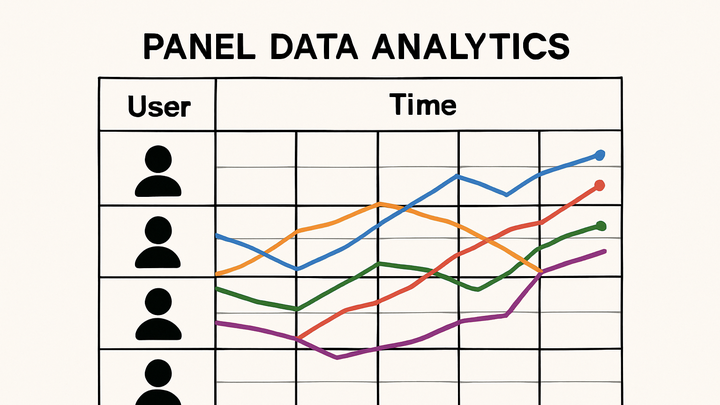Published on 2025-06-22T08:42:35Z
What is Panel Data? Examples for Analytics
Panel data is a dataset that tracks the same entities across multiple time periods, combining elements of cross-sectional and time-series data. In analytics, panel data allows you to observe how individual users or customers change their behavior over time, providing deeper insights into user journeys, retention trends, and causal relationships. Unlike aggregate snapshots, panel data maintains continuity by linking each observation to a unique panel identifier. This continuity helps control for unobserved heterogeneity and supports more accurate modeling of dynamic processes. Panel data analysis can uncover temporal patterns that single-point-in-time data would miss, such as the impact of website changes on user engagement.
By leveraging SaaS tools like PlainSignal and Google Analytics 4, analysts can implement panel data tracking in a privacy-conscious manner, using persistent identifiers and event-based models. However, panel data collection also introduces challenges related to data privacy, missing observations, and increased data volume. Proper planning, from data collection strategies to analytical methods, ensures your panel datasets remain robust, compliant, and actionable in driving business decisions.
Panel data
Panel data tracks the same units over time, combining cross-sectional and time-series views for richer, individual-level analytics.
Why Panel Data Matters
Panel data provides repeated observations for the same entities across time, enabling deeper insights into behavioral dynamics and causal relationships.
-
Enhanced trend analysis
Tracking the same subjects over time reveals individual-level patterns and shifts that aggregate metrics can obscure.
-
Causal inference
By observing changes within entities, panel data helps isolate the effects of interventions and control for unobserved variables.
-
Improved forecasting
Combining cross-sectional and temporal dimensions yields richer models with greater predictive accuracy and robustness.
Key Components of Panel Data
A panel dataset is structured around three core elements: the units being studied, the time periods observed, and a unique identifier linking observations.
-
Cross-sectional units
The individual entities tracked over time, such as users, customers, devices, or accounts.
-
Time periods
The discrete intervals (e.g., days, weeks, months) at which observations are recorded for each unit.
-
Panel identifier
A unique key or user ID that ties each observation back to the same unit across all time periods.
Collecting Panel Data with SaaS Analytics Tools
Modern analytics platforms facilitate panel data collection through user identification, event tracking, and persistent sessionization.
-
PlainSignal (cookie-free analytics)
PlainSignal uses device fingerprinting and secure server-side calls to identify recurring visitors without relying on cookies, ensuring privacy compliance.
-
Example tracking code
<link rel="preconnect" href="//eu.plainsignal.com/" crossorigin /> <script defer data-do="yourwebsitedomain.com" data-id="0GQV1xmtzQQ" data-api="//eu.plainsignal.com" src="//cdn.plainsignal.com/plainsignal-min.js"></script>
-
-
Google analytics 4 (GA4)
GA4 supports user-level event tracking with gtag.js and measurement IDs, allowing you to stitch together sessions for panel analysis.
-
GA4 tracking snippet
<!-- Global site tag (gtag.js) - Google Analytics --> <script async src="https://www.googletagmanager.com/gtag/js?id=GA_MEASUREMENT_ID"></script> <script> window.dataLayer = window.dataLayer || []; function gtag(){dataLayer.push(arguments);} gtag('js', new Date()); gtag('config', 'GA_MEASUREMENT_ID', { 'user_properties': { 'user_id': 'USER_ID' } }); </script>
-
Challenges and Best Practices
Panel data analysis brings unique challenges, requiring thoughtful strategies for data quality, privacy, and computational efficiency.
-
Data privacy and compliance
Tracking users over time can raise privacy concerns; ensure compliance with regulations like GDPR and CCPA by using anonymization and opt-in consent.
-
Handling missing data
Gaps in observations are common; employ techniques like imputation, interpolation, or models robust to unbalanced panels to mitigate bias.
-
Balancing granularity and performance
Higher temporal resolution yields detailed insights but increases data volume. Choose time buckets that capture meaningful dynamics without overloading systems.
Analyzing Panel Data
Specialized statistical methods account for correlations within units and temporal dependencies to generate valid inferences and forecasts.
-
Fixed and random effects models
Regression approaches that control for unobserved heterogeneity by allowing intercepts (and slopes) to vary across units.
-
Difference-in-differences
A quasi-experimental design comparing pre-post changes between treatment and control groups to estimate causal effects.
-
Hierarchical time-series
Mixed-effects and hierarchical models capture nested structures (e.g., users within segments) and time correlations simultaneously.
